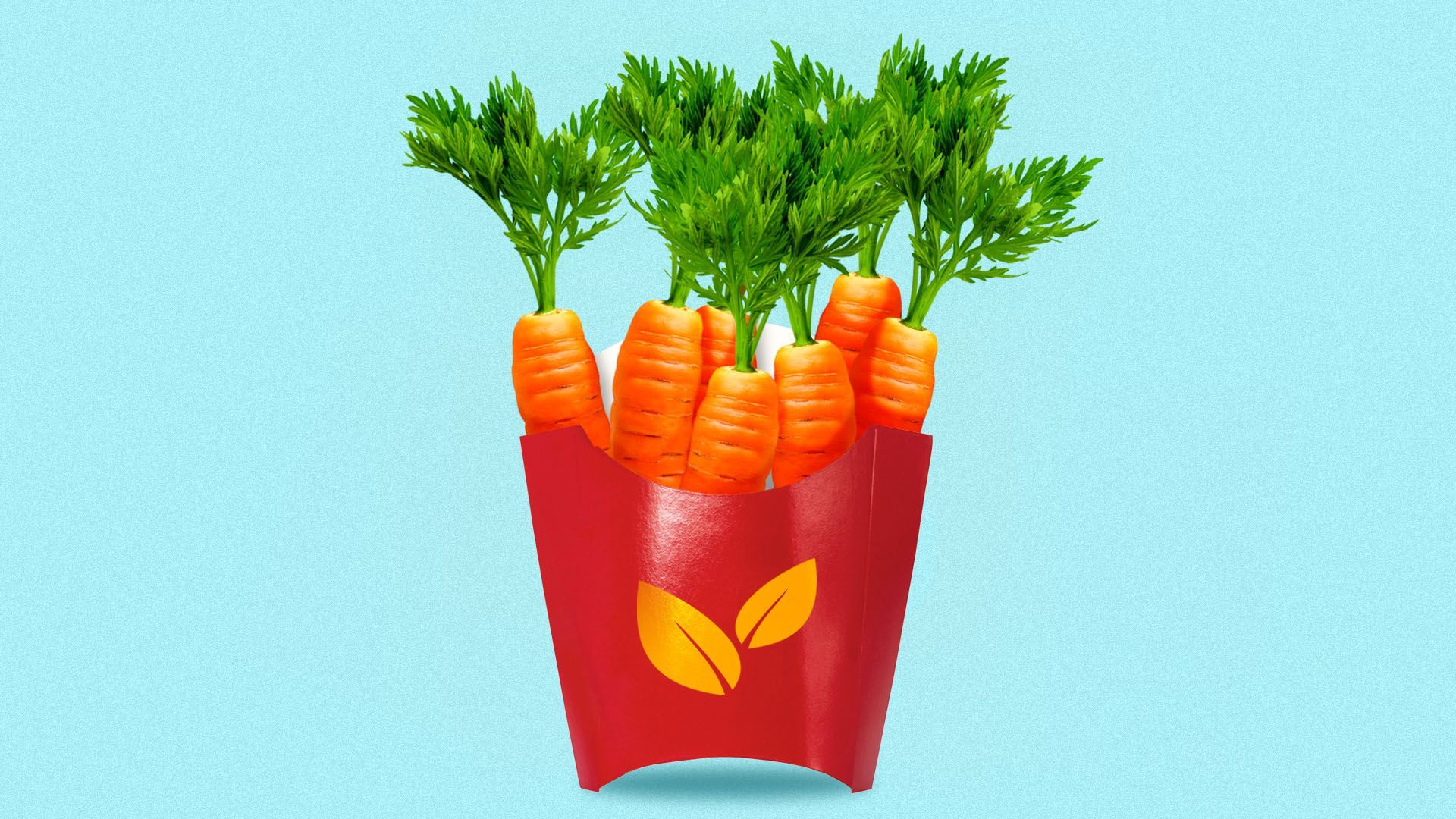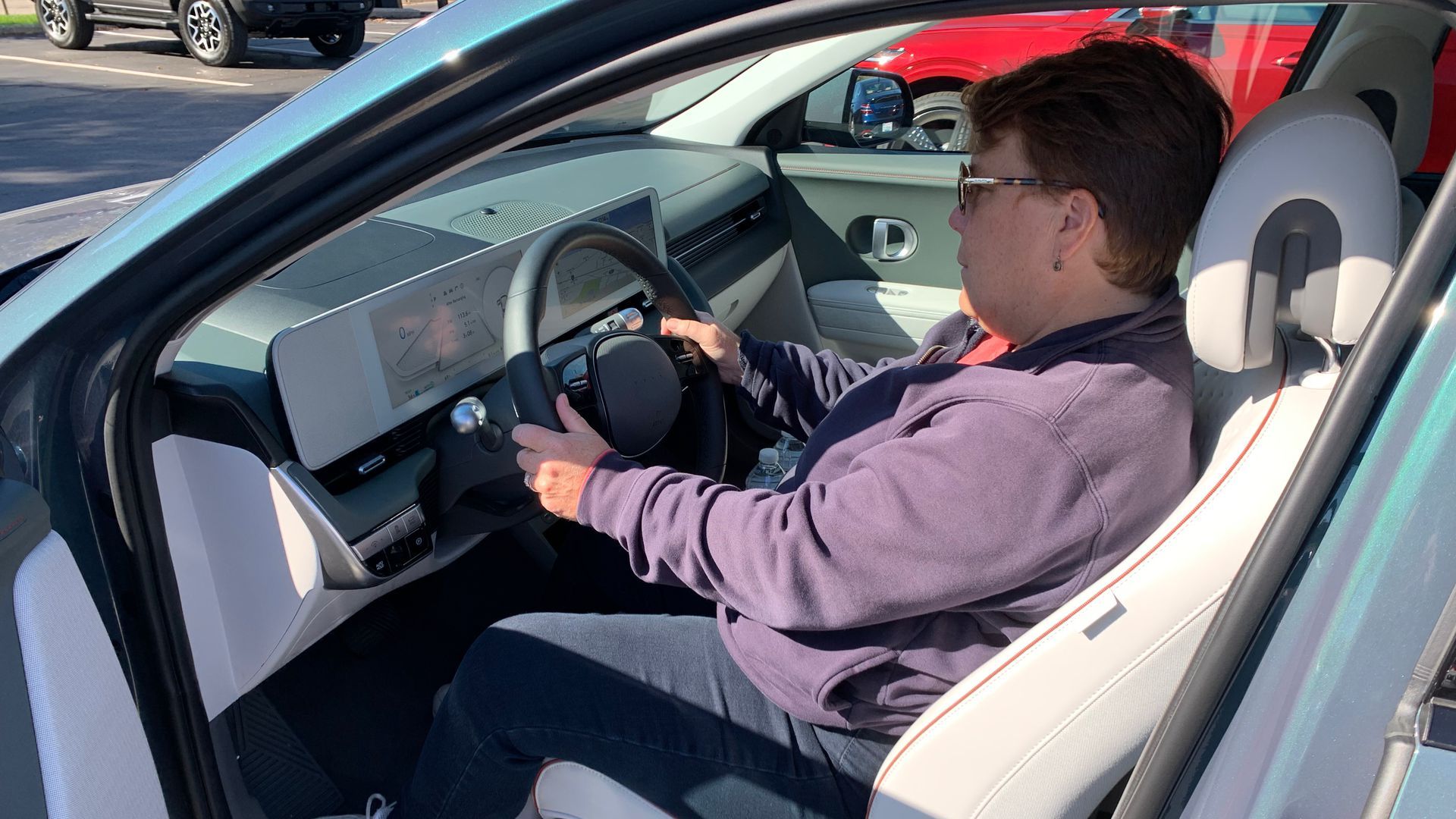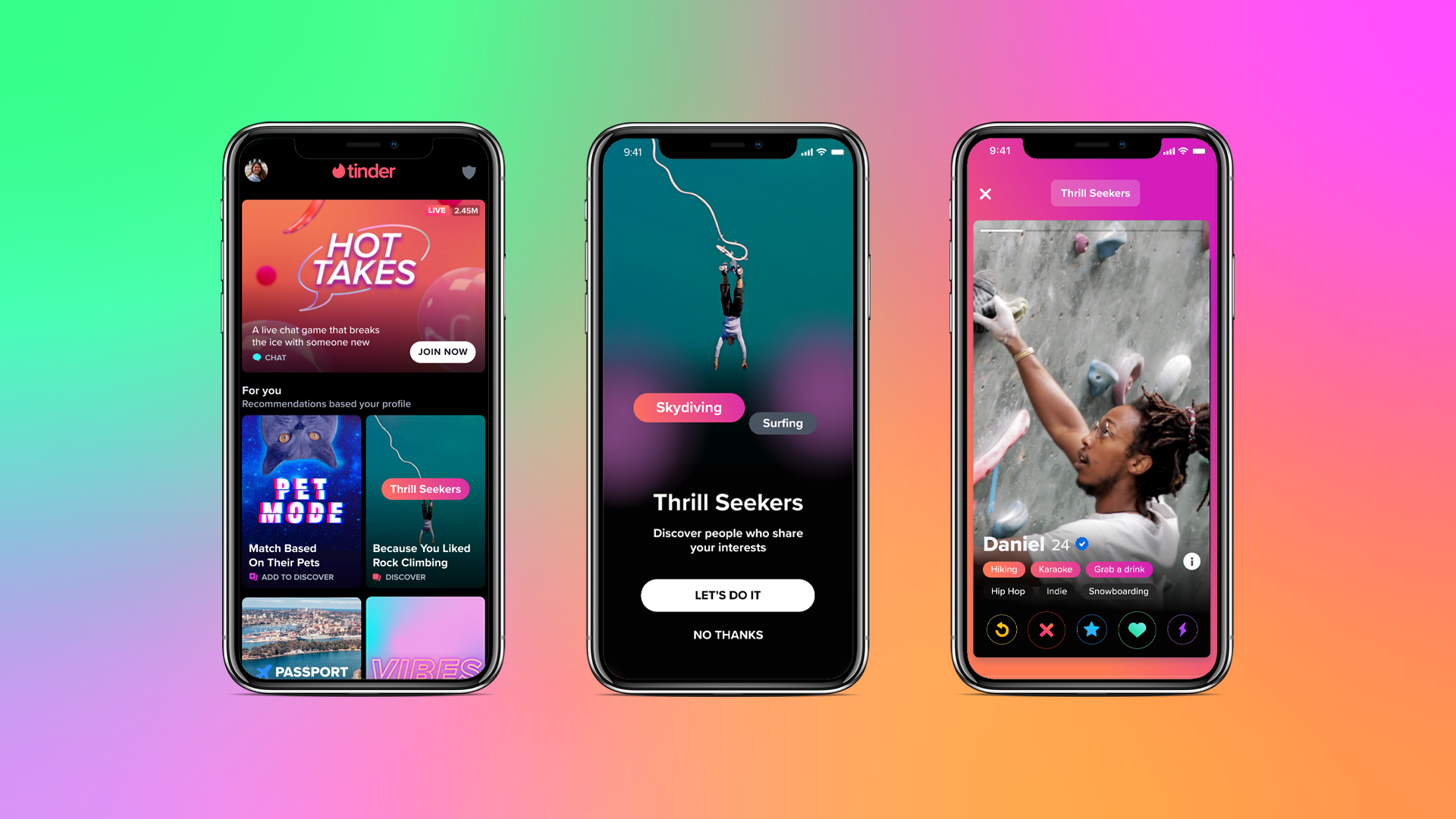| | | | | | | Presented By Okta | | | | Axios What's Next | | By Jennifer A. Kingson, Joann Muller and Erica Pandey ·Oct 22, 2021 | | As plant-based foods reach the highest levels of fine dining and start appearing on fast food menus, they're not just for vegans anymore: Two haute cuisine vegan chefs tell Erica Pandey that most of their clients are omnivores. - Joann Muller just spent two days test driving some of the year's hottest vehicles, and she gives us her picks and observations.
- Axios readers are keen on the idea of bringing their own containers to restaurants — read on.
Today's Smart Brevity count: 1,228 words ... 4.5 minutes. | | | | | | 1 big thing: The rise of vegan food in unexpected places |  | | | Illustration: Sarah Grillo/Axios | | | | Vegan cuisine is popping up in two places it wasn't present before: fine dining and fast food, Erica writes. Why it matters: The single biggest way an individual can reduce their carbon footprint is to eat less meat and dairy. Now, the popularization of meatless meals could help curb meat consumption in the U.S. What's happening: Plant-based diets are hitting both ends of the food spectrum. High-end eateries are putting out vegan tasting menus, and fast food joints are serving up fried vegan chicken and meatless burgers. - New York's 3-Michelin star Eleven Madison Park made waves this summer when it reopened after its pandemic shutdown with a fully plant-based menu, at the same steep price of $335 per person.
- "The current food system is simply not sustainable, in so many ways," chef Daniel Humm wrote in his reopening letter. "It is time to redefine luxury as an experience that serves a higher purpose and maintains a genuine connection to the community."
- And a slew of fast casual and fast food restaurants are now serving vegan alternatives to their classics. Fuku — Momofuku's fast food sister restaurant — has chicken-less versions of all its nuggets. Starbucks sells a sausage, egg and cheese breakfast sandwich with Impossible meat.
"The world is just really changing now," says Doug McNish, a vegan chef and author of several vegan cookbooks. - "As more and more people adopt this way of living, you see people of affluence — whether that's thought leaders or influencers or celebrities or entrepreneurs — becoming plant-based. And then it just spreads like wildfire."
We've grown accustomed to equating luxury with expensive meats and animal products, like lobster and foie gras, but vegan chefs are out to prove that plants can be luxurious too. - "We have dishes on our menu that take a day and a half of labor to get onto the plate," says Rich Landau, the chef behind an upscale vegan restaurant in D.C. called Fancy Radish. "There is a lot of luxury in that."
- "More people are starting to understand that food is about flavor, not flesh," he says.
Chefs keep coming up with creative ways to replace animal products with plants. "When you manipulate vegetables right, you can apply the same fine dining cooking techniques to them as you would to meat," McNish says. - Examples include watermelon instead of ahi tuna in sushi rolls and poke bowls, or spiced jackfruit as pulled pork.
- McNish serves up a king oyster mushroom calamari at one of his restaurants. The mushrooms are sliced thin and the center is punched out to resemble calamari, and then it's deep-fried with the same flavors.
Read the full story. |     | | | | | | 2. What we're driving: the year's best vehicles |  | | | Joann Muller in the battery-electric Hyundai Ionic 5, which has a futuristic interior. Photo: Miles Johnson for Axios | | | | This week, I spent two glorious fall days evaluating dozens of cars, trucks and SUVs on the roads near Ann Arbor, Michigan, to determine the best of the best, Joann writes. Why it matters: The annual comparison drive brings together 50 professional automotive journalists from the U.S. and Canada who are jurors for the independent North American Car, Truck and Utility Vehicle of the Year awards. - I test drive new cars all year long, but the opportunity to compare vehicles back to back, on the same routes — and to share impressions with my fellow jurors — is invaluable.
- It's also a great opportunity to talk to the engineers who designed them, to learn more about what makes each model unique.
How it works: There are three rounds of voting to winnow down the list of new or substantially changed vehicles each year. - This week we compared the 23 semifinalists — eight cars, six trucks and nine utility vehicles (many with multiple powertrains or trim levels) — to pick the finalists. These will be announced Nov. 17 at Automobility LA, the preview event for the Los Angeles Auto Show.
- Winners in each category will be announced in January.
I'm still weighing my picks, but here are some key takeaways after two days of comparison driving: - Touchscreens are getting bigger and more distracting.
- Knobs are actually useful — please put them back!
- Battery electric models are becoming mainstream.
- Assisted driving systems are getting more intuitive.
- Luxury models are really just like your family room on wheels.
- More to come on all these trends soon.
I'll leave you with two surprise contenders from the week: - Rivian's R1T electric pickup truck. At $73,000, the first vehicle from the EV startup surprised many journalists for its quality and attention to detail. It's still early, though, and the question is whether this newcomer can master mass production.
- Ford's Maverick hybrid pickup. There's a ton of value in this little pickup, which starts under $20,000 and gets 42 miles per gallon in city driving. It's the answer for climate-conscious drivers on a budget who want a truck but have been priced out of the market.
The catch: Only one can be truck of the year. Share this story. |     | | | | | | 3. Job security improves for lower-income Americans |  Data: Morning Consult/Axios Inequality Index; Chart: Axios Visuals Polling for the Morning Consult/Axios Inequality Index suggests that as the Delta variant ebbed over the last month, job security improved for lower-income Americans, writes Kate Marino of Axios Markets. The big picture: As a result of the improving environment, the Inequality Index this month declined to its lowest point since April — reversing a significant spike in September. The details: The share of workers earning less than $50,000 a year expecting to experience a loss of employment income in the next four weeks fell to 14.9% in October from 16.8% in September. - Adults in the same category who lacked savings to cover basic expenses for one month fell by more than 3 percentage points to 27.7%.
Read the full story. |     | | | | | | A message from Okta | | Give your workforce secure access to what they need the most | | |  | | | | With Okta, your organization can secure and enable employees, contractors, and partners --- wherever they are, and whatever they do. Your people are your future. Protect them. Learn why companies around the world trust Okta for workforce identity. | | | | | | 4. Survey says: Axios readers want DIY takeout options |  Chart: Axios This week, we ran a story about Monica Eng of Axios Chicago ordering food from a local restaurant on plates and then packing it in her own containers to avoid using more disposable plastic. 📬 We asked readers of Axios What's Next and Axios Chicago if you'd patronize restaurants more if they let you do this, and you overwhelmingly wanted the option! |     | | | | | | 5. 1 fun thing: Swipe for your wedding plus-one |  | | | Tinder's Explore page, where users can find social experiences. Photo: Tinder | | | | Weddings have come roaring back, and now you can swipe right for to find a date on Tinder who will go with you, Erica writes. By the numbers: Due to the pandemic backlog, there will be some 2.5 million weddings in the U.S. in 2022, the highest number since 1984, according to The Wedding Report. And mentions of "plus one" in Tinder users' bios has jumped 45% as a result, per Tinder data. What's happening: Tinder has an "Explore" page in the app that lets users join interest groups — such as extreme sports — or look for partners through social experiences, like in-person speed dating. - Now the dating app has added a new group to "Explore" called "Plus One," which swipers can join to find dates for weddings or other events.
My thought bubble: Sure, a wedding can feel like one of the worst places to fly solo. But is it really better to bring someone along as a first or second date? That seems like a lot of pressure (and a potential recipe for disaster). - Plus, think of how the bride and groom may feel about having a rando on their special day (and in their pictures).
We'd love to hear your thoughts! Would you use Tinder's "Plus One" feature? Would the single folks in your life use it? Send us a note at whatsnext@axios.com. Share this story. |     | | | | | | A message from Okta | | Protect customers with Okta's modern identity solutions | | |  | | | | Retailers around the world use Okta to power their most important customer-facing initiatives. Here's why: Engaging your customers online is essential – and keeping them safe is crucial. Learn how Okta can support your most important customer-facing initiatives. | | | | Was this email forwarded to you? Get the daily dose of What's Next magic by signing up for our free newsletter here. |  | | It'll help you deliver employee communications more effectively. | | | | | | Axios thanks our partners for supporting our newsletters. If you're interested in advertising, learn more here.
Sponsorship has no influence on editorial content. Axios, 3100 Clarendon Blvd, Suite 1300, Arlington VA 22201 | | | You received this email because you signed up for newsletters from Axios.
Change your preferences or unsubscribe here. | | | Was this email forwarded to you?
Sign up now to get Axios in your inbox. | | | | Follow Axios on social media:    | | | | | |









No comments:
Post a Comment